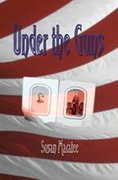
With The Model Man released and my work load gradually easing up, I’m finally able to get back to the historical research I’ve started—and abandoned—and started again—so many times.
My hero is a sometime-snake-oil salesman, not above taking money from innocent farmers who are convinced he can make it rain or selling the odd elixir guaranteed to cure all ills. But more often than not he makes his living as a gambler (just so long as he’s not making an honest living, this guy is happy. Some hero, huh?). And like most gamblers from the old west, he’s not above using gadgets and gizmos to eliminate chance and tilt the scales in his favor.
Here are some of the things I’ve come across in my research that he –and other cardsharps like him--might have used to ply his trade.
Blue tinted spectacles. This one threw me. I never dreamed they had anything this advanced in the Old West. These enable the wearer to detect the phosphorescent ink on marked cards—which is invisible to the naked eye.
Card Trimmer. This could be used to mend the frayed edges of an old deck—or to shave a tiny portion from certain cards to make them easy to find in the deck.
Corner rounder. The companion to the card trimmer. Used to cut new corners on an entire deck, or to mark particular cards by slightly altering the corners.
Card pricker. This little brass plunger would drive a needle into the face of the card and raise a tiny mark on the back—think Braille—the dealer could tell by the positions of the bumps which cards were sliding through his fingers.
Marked Cards. The most popular and the thing that first came to my mind. Special markings on the cards reveal their value to the dealer, usually by a symbol innocently hidden in the design on the back of the deck. This symbol would rotate clockwise depending on the face value of the card. (Suits were less important than number cards in many games, so they were often left unmarked.)
Holdouts were ingenious devices designed to let the gambler "hold out" certain cards and play them when the time was right and the pot was full:
Sleeve holdout. This device featured an extra wide cuff that buckled around the wearer’s upper arm and extended a playing card into his palm when he bent his elbow.
Breastplate hold out. This was sewn inside the gambler’s coat and attached by a long cord to his boot. He could conceal or produce an entire hand of cards simply by stretching or bending his leg.
Hold out vest. This vest had a single strip of elastic sewn into it to hold a card or two—and included an additional loop for a small pencil used to mark cards.
Fanny pack hold out? LOL. Not sure what this one was called. But a pouch that looks amazingly like a fanny pack was strapped about the waist under the gambler’s vest. It contained a spring-loaded frame that would hold several cards or an entire deck in reserve for just the right moment. Like the breastplate holdout, it was manipulated by the wearer’s leg.
The Kepplinger holdout. The finest of its class and undoubtedly the most famous of the holdout devices. This harness of pulleys, cords and telescoping silver-plated tubes reached from a man’s forearms down to his knees. The gambler would activate this device by simply spreading his knees ever so slightly and the claw like “sneak” hidden beneath two layers of a special double shirt sleeve moved the cards into his hand. For a description and a drawing http://cardshark.us/holdouts_frs.shtml
Source: The Old West Time Life Series: The Gamblers.
And http://en.wikipedia.org/wiki/Holdout











